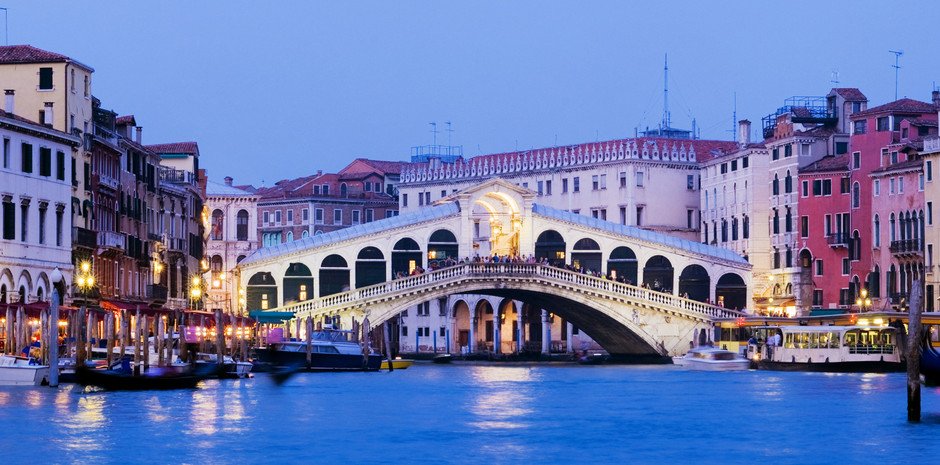
Venice is divided into six districts ie common areas, streets are named for streets, creeks, wrinkles, salizzade
which open all channels on the foundation of the roads that parallel to a channel or wide open spaces in these fields or squares. Piazza San Marco is only while the squares are two: one that opens on the basin of S. Marco limited by the Ducal Palace and the Old Library and the call of Leonini, the left side of the basilica.
There are no sounds of cars, cars, wagons, bicycles, we hear only the hiss of the sirens of the boats and motor launches, the roar of motorboats, the splash of the oars of the gondolas all painted in black under a law of sec. XV, and already mentioned in a paper of 1094 and the song of the gondolier. To switch from one bank of the Grand Canal, there are three Accademia bridge, Rialto and stations, and ferry stations served by gondolas. The 160 channels are crossed by about 400 bridges. The islands that are not part of the core of the city are: the Giudecca islands formed by 8, with the Church of the Redeemer, St. Giorgio Maggiore Murano famous worldwide for its mosaics, the glass industry and the museum of the craft, the group of Burano, a fishing center, is known for its lace renowned throughout the world; Torcello Today the village, with venerable monuments of its ancient grandeur; S. Lazarus S. Servolo, Lido, elegant cosmopolitan resort, which separates the lagoon from the open sea.
City Center is the wide piazza S. Marco looks like a huge hall enclosed by a marble facade of the basilica, the Clock Tower, the Procuratie old man with a portico of 50 arches and two overlapping rows of windows, seat of the Procurators of S. Marco, the new factory built in 1810 developing the design concept of the Procuratie Nuove.
The porch at the entrance to the middle is where are the Correr Museum containing a fine collection of memories and recollections of life in Venice and New Procuratie of 1584-1640, becoming the Napoleonic era palace, now the Civico Museo Correr . The basilica of San Marco 829-32 kinds, from the Doge Contarini rebuilt after a fire in 976, consecrated in 1094, was later embellished with precious marbles and mosaics, with a facade of incomparable beauty and richness of marbleBefore. Southeast corner of the square stands the 99 m-high bell tower, rebuilt in 1912, at whose base set against the marble loggia of St. Marco adorned by statues of Pallas, Apollo, Mercury, Peace.
The clock tower of 1496, flanked by two wings carrying a huge golden dial and is topped by two statues of the Old Library bronzo.La of 1536, two orders: the Doric portico, Ionic on the upper floor with the central portal of the porch flanked caryatids by two huge monumental staircase and contains precious codices, incunabula, miniatures and the famous world map of Fra Mauro of 1549. In the porch of the Old Library is the entrance to the archaeological museum and in continuity with it, on the side to the pier, is the brand that now houses the Biblioteca Nazionale Marciana in 1468.
The Palazzo Ducale, home of the doge and the most important magistrates, whose monumental entrance is the Charter opens the door to the basilica, was built to 1’814 reconstructed in two stages between 1309-1404 and 1424-1442 devastated by fire and restored in 1483 is an original building that shows the power and the glory of the republic.
From the deck of straw on the pier, look at the side of the Ducal Palace and the Bridge of Sighs of 1600 where the prisoners who passed through the prisons of wells or Lead; built in 1589 were introduced at the inquisitors of state.
Many are on the Grand Canal palaces and monuments worthy of mention, which follow each other from the basin of S. Marco, but would remember them all along. We therefore limit ourselves to some of the most important: the Punta della Salute and the Dogana di mare topped by the revolving statue of Fortune, and the church of S. Maria della Salute in 1631, the right of the patriarchal seminary the art gallery containing Manfrediniana; the Palazzo Rezzonico 1680, home of the Museum of Eighteenth Century Art; Corner della Ca ‘Grande, 1522, now the seat of the prefecture; Foscari University Institute of Economics and Commerce; Mocenigo; Grimani 1550, when the court of appeal; Camerlenghi 1526-28, with rich decoration, Pesaro 1710, when the Gallery of Modern Art and the Museum of Oriental Art, Vendramin-Calergi, where Wagner died in 1883 . Other notable buildings are the Contarini-Seriman Gothic-Venetian 1450, Giovannelli the year 1400, Correr, Vendramin, Lezze 1654, Labia with famous frescoes by Tiepolo, Trevisan, Zaguri, Pisani of 600, and: the Ca ‘ Golden erected in 1440-1442, with Venetian Gothic style, now houses the Galleria Franchetti, the Foundation co Turks of the thirteenth century, now houses the Museum of Natural History, the Fondaco the Germans, now central.
